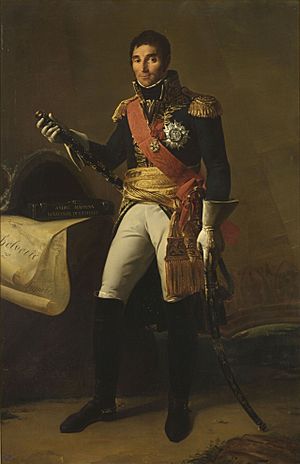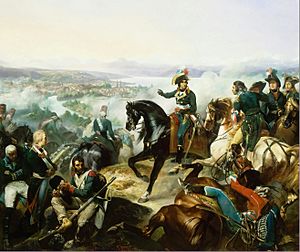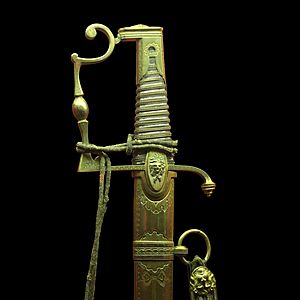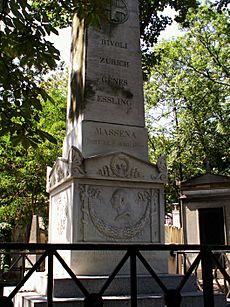André Masséna facts for kids
Quick facts for kids
Marshal of the Empire
André Masséna
Duke of Rivoli, Prince of Essling
|
|
|---|---|

Portrait of Masséna made c. 1853 after an 1814 original by Antoine-Jean Gros
|
|
| Nickname(s) | l'Enfant chéri de la Victoire |
| Born | 16 May 1758 Nice, Kingdom of Sardinia |
| Died | 4 April 1817 (aged 58) Paris, France |
| Buried |
Père Lachaise Cemetery, Paris, France
|
| Allegiance | |
| Service/ |
Army |
| Rank | Marshal of the Empire |
| Battles/wars | French Revolutionary Wars, Napoleonic Wars |
| Awards | Grand Cross of the Legion of Honour |
| Signature |  |
André Masséna (born Andrea Massena; 16 May 1758 – 4 April 1817) was a very important French military leader. He fought during the French Revolutionary Wars and the Napoleonic Wars. He was one of the first 18 Marshals of the Empire chosen by Napoleon I. His nickname was l'Enfant chéri de la Victoire, which means "the Dear Child of Victory".
Many of Napoleon's generals went to the best military schools. However, Masséna became a great leader without a formal education. While noble people got their education and promotions easily, Masséna came from a simple background. He rose to such a high position that Napoleon called him "the greatest name of my military empire." His military career was truly amazing.
Masséna's leadership also helped many other French marshals. Most of them served under his command at some point in their careers.
Contents
Early Life and Military Start
Masséna was born in Nice on 16 May 1758. At that time, Nice was part of the Kingdom of Sardinia. His father, Jules Masséna, was a shopkeeper who later became a wine merchant. His mother was Marguerite Fabre.
When Masséna was six, his father died. After his mother remarried, he went to live with his father's relatives. At 13, he became a cabin boy on a merchant ship. He sailed in the Mediterranean Sea and went on two long trips to French Guiana.
In 1775, after four years at sea, he returned to Nice. He joined the French Army as a private soldier in the Royal Italian Regiment. By 1789, he had reached the rank of warrant officer. This was the highest rank a non-noble person could achieve. On 10 August 1789, he married Anne Marie Rosalie Lamare. She was the daughter of a surgeon in Antibes. They lived in her hometown. In 1791, he rejoined the army and quickly became an officer. By 1792, he was a colonel.
Revolutionary Wars: A Rising Star
When the French Revolutionary Wars began in April 1792, Masséna and his group of soldiers were sent to the border near Piedmont. Masséna prepared his soldiers well. In October, his group became part of the French Armée d'Italie.
Masséna showed great skill in battle and was quickly promoted. He became a général de brigade in August 1793. By December, he was a général de division. He was important in every campaign in Italy over the next two years. This included the attack on Saorgio in 1794 and the Battle of Loano in 1795.
When Napoleon Bonaparte took command in March 1796, Masséna was leading the army's advance guard. During the campaign in Italy from 1796-1797, Masséna became one of Bonaparte's most important helpers. He played a big part in many battles, including Montenotte, Dego, Lonato, Castiglione, Bassano, Caldiero, and Arcola. He was also key in the Battle of Rivoli and the fall of Mantua.
The Battle of Rivoli and Mantua
In January 1797, an Austrian army tried to help Mantua, a city under siege. French forces were struggling near Rivoli. Masséna was ordered to march 15 miles from Verona to Rivoli. His troops marched all night through snow and arrived at 6:00 A.M. Bonaparte placed them on the left side of the battle. They then moved to help the middle and stop an Austrian attack. Masséna's troops were crucial to the French victory.
The next day, with little rest, Masséna and his soldiers marched 39 miles in 24 hours. They went to stop another Austrian army trying to help Mantua. At La Favorita, they trapped the Austrian army, forcing them to surrender. In just five days, Masséna's group helped capture or kill over 35,000 Austrian soldiers. Two weeks later, the 30,000 soldiers in Mantua surrendered. Napoleon praised Masséna, calling him l'enfant chéri de la victoire (the dear child of victory).
Masséna in Switzerland

In 1799, Masséna was given an important command in Switzerland. He had to defend the entire border with about 90,000 men. He pushed back Archduke Charles's attack on Zurich in June.
In September, he won a great victory over the Russians at the Second Battle of Zurich. Then, he quickly moved his troops south to face another Russian general, Alexander Suvorov. Masséna's forces delayed Suvorov at Gotthard Pass. When Suvorov finally got through, he was met by more French troops. Suvorov could not break through the French lines. He had to escape across a very difficult mountain pass, losing many men and supplies. This victory helped lead to Russia leaving the war.
The Siege of Genoa
In 1800, Masséna was trapped in Genoa, Italy, by the Austrians. Meanwhile, Napoleon was marching with his army to Milan. By late May, a disease had spread in Genoa, and people were revolting. Masséna's troops were starving.
On 4 June, with only one day's food left, Masséna agreed to leave Genoa. But he insisted it was not a "capitulation" (surrender). His starving and tired troops marched out of the city with all their equipment. This siege lasted almost 60 days. It showed Masséna's amazing determination and courage.
By keeping the Austrians busy at Genoa, Masséna allowed Napoleon to surprise the main Austrian army at Marengo and defeat them. Less than three weeks later, Napoleon wrote to Masséna, giving him command of the "first army of the Republic." Even the Austrians admitted that Masséna's defense of Genoa was key to Napoleon's victory.
Napoleonic Wars: Marshal of the Empire
Masséna regained Napoleon's full trust in 1804. That year, he was made a Marshal of the Empire. He led an army that captured Verona and fought the Austrians in 1805. He was given control of operations against the Kingdom of Naples. In 1808, he was given his first ducal title, Duke of Rivoli.
In 1808, Masséna was accidentally shot during a hunting trip. It's not clear if Napoleon or another marshal shot him, but he lost the use of one eye.
Key Battles and Titles
Masséna returned to active service in 1809. He led soldiers in battles like Eckmühl and Ebersberg. Later, at the Battle of Aspern-Essling, Masséna's troops bravely held the village of Aspern for two days of fierce fighting. For his efforts there and in the Battle of Wagram, he was given a second title in 1810: Prince of Essling.
During the Peninsular War, Napoleon made Masséna Commander of the Army of Portugal in 1810. Masséna captured Ciudad Rodrigo and Almeida. However, he faced a strong British and Portuguese army led by the Duke of Wellington at Buçaco. Masséna pushed the allies back to the Lines of Torres Vedras, where they stopped his advance for months.
Eventually, Masséna had to retreat due to lack of food. Napoleon was reportedly disappointed. After more defeats, he was replaced and did not serve in major campaigns again. He became a local commander in Marseille.
Retirement and Legacy
After Napoleon's first defeat, Masséna briefly kept his command under King Louis XVIII. But he was soon removed because of his past with Napoleon. When Napoleon returned from exile in 1815, Masséna supported him again. He was made a Peer of France but remained a local commander.
After Napoleon's final defeat, Masséna was named head of the National Guard in Paris. However, he was soon replaced when the old royal family returned to power. Masséna died in Paris in 1817. He was buried at Père Lachaise Cemetery with his son-in-law, Honoré Charles Reille.
Family Life
Masséna's wife, Anne Marie Rosalie Lamare, stayed at their home in Antibes during his military campaigns. They had four children:
- Marie Anne Elisabeth (born 1790, died 1794)
- Jacques Prosper (born 1793), who became the 2nd Prince of Essling.
- Victoire Thècle (born 1794), who married Honoré Charles Reille.
- François Victor (born 1799), who became the 2nd Duke of Rivoli and 3rd Prince of Essling.
Masséna's Legacy
Masséna is remembered in several places:
- One of the Boulevards of the Marshals that circle Paris is named after him. There is also a bridge in Paris with his name.
- The village of Massena in New York was settled by French lumbermen in the early 1800s and named in his honor.
- Massena, Iowa, in the United States, is also named after him. It has a portrait of him in Centennial Park.
- His birthplace, Nice, has a famous square called Place Masséna.
In Literature
- Masséna appears in some of Sir Arthur Conan Doyle's stories about Brigadier Gerard.
- He is also a character in Bernard Cornwell's novels Sharpe's Escape and Sharpe's Battle. These books describe France's attempt to invade Portugal in 1810.
Images for kids
-
Masséna as a general of the French Revolutionary Army, 1796
See Also
 In Spanish: André Masséna para niños
In Spanish: André Masséna para niños






